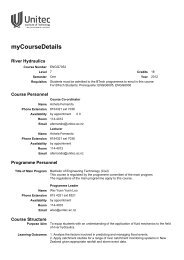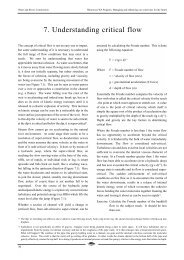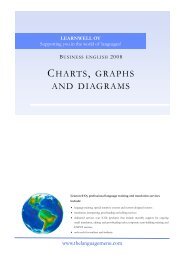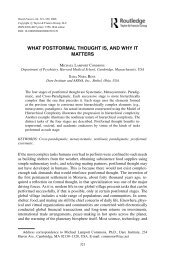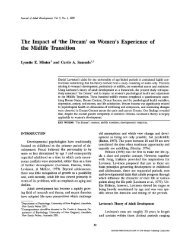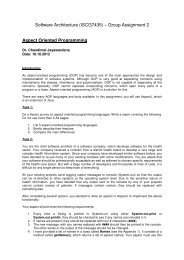Moral Development and Moral Education: An Overview
Moral Development and Moral Education: An Overview
Moral Development and Moral Education: An Overview
You also want an ePaper? Increase the reach of your titles
YUMPU automatically turns print PDFs into web optimized ePapers that Google loves.
elieved that his hitting a power pole with his baseball bat caused a major power blackout in the New<br />
York city area.<br />
The second major contributor to heteronomous moral thinking in young children, is their relative<br />
social relationship with adults. In the natural authority relationship between adults <strong>and</strong> children, power<br />
is h<strong>and</strong>ed down from above. The relative powerlessness of young children, coupled with childhood<br />
egocentrism feeds into a heteronomous moral orientation.<br />
However, through interactions with other children in which the group seeks a to play together in a<br />
way all find fair, children find this strict heteronomous adherence to rules sometimes problematic. As<br />
children consider these situations, they develop towards an "autonomous" stage of moral reasoning,<br />
characterized by the ability to consider rules critically, <strong>and</strong> selectively apply these rules based on a<br />
goal of mutual respect <strong>and</strong> cooperation. The ability to act from a sense of reciprocity <strong>and</strong> mutual<br />
respect is associated with a shift in the child's cognitive structure from egocentrism to perspective<br />
taking. Coordinating one's own perspective with that of others means that what is right needs to be<br />
based on solutions that meet the requirements of fair reciprocity. Thus, Piaget viewed moral<br />
development as the result of interpersonal interactions through which individuals work out resolutions<br />
which all deem fair. Paradoxically, this autonomous view of morality as fairness is more compelling<br />
<strong>and</strong> leads to more consistent behavior than the heteronomous orientation held by younger children.<br />
Piaget concluded from this work that schools should emphasize cooperative decision-making <strong>and</strong><br />
problem solving, nurturing moral development by requiring students to work out common rules based<br />
on fairness. This is a direct rejection of sociologists Emile Durkheim's view of proper moral education<br />
(1925/1961). Durkheim, similar to Piaget, believed that morality resulted from social interaction or<br />
immersion in a group. However, Durkheim believed moral development was a natural result of<br />
attachment to the group, an attachment which manifests itself in a respect for the symbols, rules,<br />
<strong>and</strong> authority of that group. Piaget rejected this belief that children simply learn <strong>and</strong> internalize the<br />
norms for a group; he believed individuals define morality individually through their struggles to arrive<br />
at fair solutions. Given this view, Piaget suggested that a classroom teacher perform a difficult task:<br />
the educator must provide students with opportunities for personal discovery through problem solving,<br />
rather than indoctrinating students with norms.<br />
<strong>An</strong> excellent contemporary adaptation of Piaget's theory for moral development of young children<br />
may be found in DeVries, R. & Zan, B. (1994). "<strong>Moral</strong> Children: Constructing a Constructivist<br />
Atmosphere in Early <strong>Education</strong>." New York: Teachers College Press. You may preview some portions<br />
of that book within the FEATURED PRACTICES segment of this WEB site. DeVries <strong>and</strong> Zan go<br />
beyond Piaget's original work to include that of more recent theorists including Lawrence Kohlberg<br />
whose theory will be described next.<br />
II. Kohlberg's Theory of <strong>Moral</strong> <strong>Development</strong> <strong>and</strong> <strong>Education</strong><br />
<strong>Moral</strong> <strong>Development</strong><br />
Lawrence Kohlberg (1969) modified <strong>and</strong> elaborated Piaget's work, <strong>and</strong> laid the groundwork for<br />
the current debate within psychology on moral development. Consistent with Piaget, he proposed that<br />
children form ways of thinking through their experiences which include underst<strong>and</strong>ings of moral<br />
concepts such as justice, rights, equality <strong>and</strong> human welfare. Kohlberg followed the development of<br />
moral judgment beyond the ages studied by Piaget, <strong>and</strong> determined that the process of attaining<br />
moral maturity took longer <strong>and</strong> was more gradual than Piaget had proposed.<br />
On the basis of his research, Kohlberg identified six stages of moral reasoning grouped into three<br />
major levels. Each level represented a fundamental shift in the social-moral perspective of the<br />
individual. At the first level, the preconventional level, a person's moral judgments are characterized<br />
by a concrete, individual perspective. Within this level, a Stage 1 heteronomous orientation focuses<br />
on avoiding breaking rules that are backed by punishment, obedience for its own sake <strong>and</strong> avoiding<br />
the physical consequences of an action to persons <strong>and</strong> property. As in Piaget's framework, the<br />
reasoning of Stage 1 is characterized by ego-centrism <strong>and</strong> the inability to consider the perspectives of<br />
others. At Stage 2 there is the early emergence of moral reciprocity. The Stage 2 orientation focuses<br />
on the instrumental, pragmatic value of an action. Reciprocity is of the form, "you scratch my back<br />
<strong>and</strong> I'll scratch yours." The Golden Rule becomes, "If someone hits you, you hit them back." At Stage<br />
2 one follows the rules only when it is to someone's immediate interests. What is right is what's fair in<br />
the sense of an equal exchange, a deal, an agreement. At Stage 2 there is an underst<strong>and</strong>ing that



